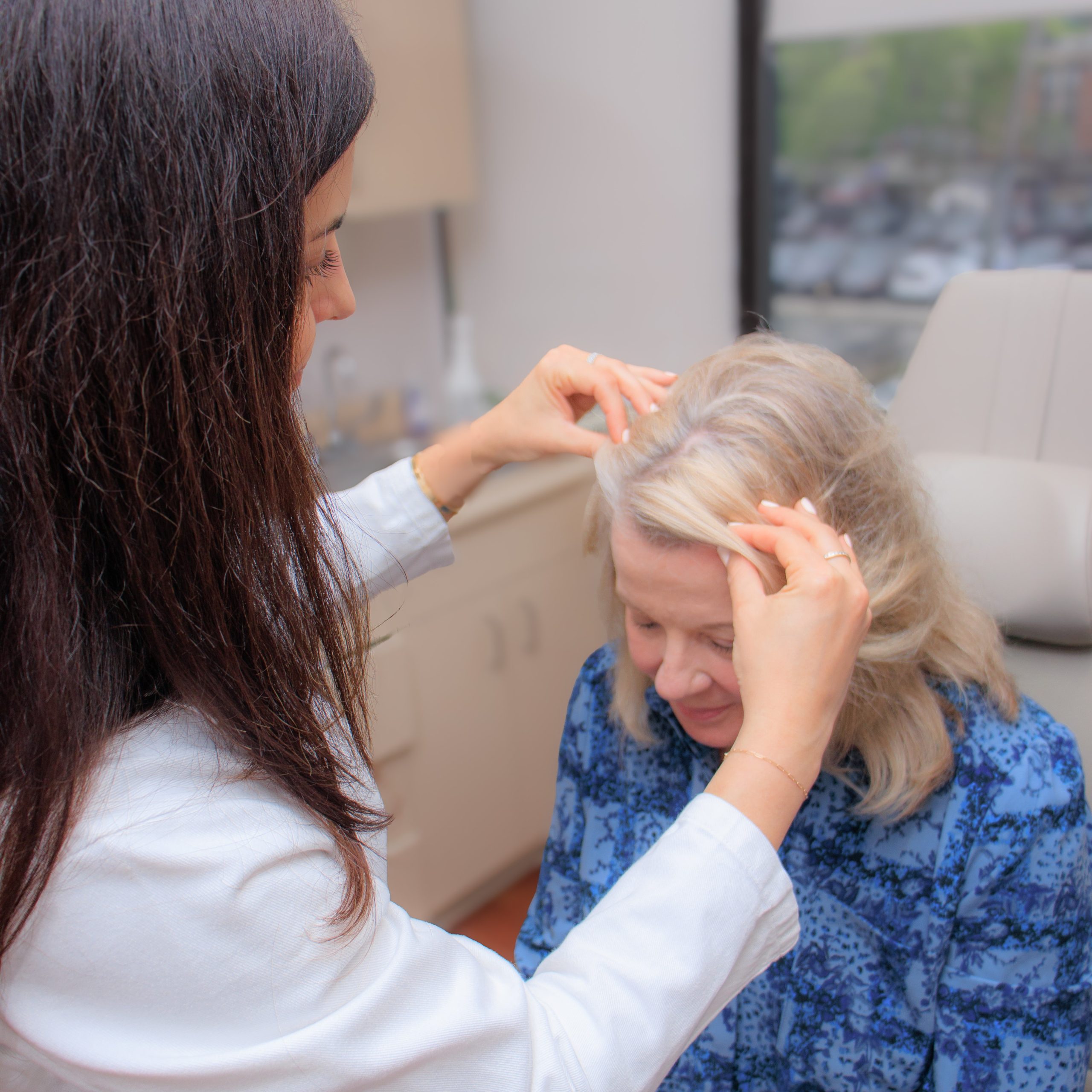- Home
- Blog
- Hair Treatments
- Signs of Impending Hair Loss: When to Seek Help from Your Dermatologist
Signs of Impending Hair Loss: When to Seek Help from Your Dermatologist
 Hair loss isn’t just cosmetic, it’s a medical issue and often a reflection of our body’s internal health. In many cases, early intervention can delay or even prevent further hair thinning or shedding. Recognizing the first signs of hair loss is essential so you can act quickly. Dr. Molly Stout shares what to look for and when it’s time to call your dermatologist.
Hair loss isn’t just cosmetic, it’s a medical issue and often a reflection of our body’s internal health. In many cases, early intervention can delay or even prevent further hair thinning or shedding. Recognizing the first signs of hair loss is essential so you can act quickly. Dr. Molly Stout shares what to look for and when it’s time to call your dermatologist.
You’ve discovered a small hairless patch on our scalp
A well-defined, round bald spot that appeared with no symptoms like pain, burning or itching, may be the first sign of alopecia areata, an autoimmune condition where your immune system attacks your hair follicle. These spots usually require early treatment for best results, so consult your dermatologist as soon as possible. For the past several years, we’ve had access to exciting breakthrough therapies that are especially effective when the hair loss is patchy.
You’ve made a big change to your diet or started semaglutide medication
Significant changes in nutrition or metabolism, such as strict dieting or starting medications like semaglutide, can lead to telogen effluvium, a diffuse shedding of hair across the scalp. If your diet lacks iron or protein, or your appetite has dropped significantly, your hair may respond by shedding more than usual.
You’ve been diagnosed with anemia or might have it
Iron deficiency, especially common in young menstruating women, is a major contributor to hair loss. If you’re noticing increased shedding and also experiencing fatigue or shortness of breath, anemia may be a root cause. Our dermatologists will typically run basic labs like an iron panel to help identify and address it. Correcting your iron deficiency should help improve your hair loss.
Your thyroid may be responsible for your hair shedding
Thyroid dysfunction, whether overactive or underactive, can cause hair to shed diffusely. This type of loss is typically reversible with proper treatment. If you’re also feeling tired, noticing weight changes, or experiencing mood shifts, there is a chance that you have an underlying thyroid condition. You should mention these symptoms to your dermatologist or even your primary care doctor, who will most likely order a simple blood test to uncover the culprit.
Your forehead seems to be growing
If your frontal hairline is receding with prominent blood vessels on the forehead or changes to the skin appearance (e.g., tighter, paler, or shinier), frontal fibrosing alopecia may be to blame. This is an inflammatory form of scarring hair loss – your immune system attacks your hair follicles and lay down scar tissue – that often comes on gradually. Our dermatologists advise against waiting as early topical, oral and procedural treatments can prevent permanent follicle damage and preserve hair density.
Your eyebrows are thinning without explanation
Eyebrows offer important clues. Gradual thinning can be part of aging, but sudden or patchy eyebrow loss could signal alopecia areata, frontal fibrosing alopecia, or even thyroid disease (especially if the outer brow is thinning).
You’ve been wearing tight hairstyles, like braids
Traction alopecia occurs when constant pulling slowly damages the hair follicles, especially around the hairline and temples. While not everyone is affected by tight hairstyles, some individuals may be more prone. If caught early, the process can be stopped or reversed. Dr. Stout recommends wearing your loose as much as possible.
Your scalp is itchy, painful, or covered in flakes
Persistent scalp inflammation from conditions like psoriasis or other inflammatory disorders weaken hair follicles and can result in hair loss. If you’re noticing redness, itching, scaling, or discomfort on your scalp, it’s time to see a dermatologist for diagnosis and targeted treatment. Topical, oral, and injectable medications for psoriasis can mitigate symptoms. Also note that psoriasis on other parts of the body increases the likelihood of an inflammatory form of hair loss.
Your hair is coming out in clumps months after a major event
Three to four months after surgery, childbirth, illness, or other physical stressors, many people experience telogen effluvium. Though the shedding can feel severe, this type of hair loss is usually temporary. Still, our dermatologists can help confirm the diagnosis and monitor recovery.
Your hair thinning is starting at the crown
In women of African descent, hair loss at the crown may point to central centrifugal cicatricial alopecia, another scarring and inflammatory condition that can also cause burning, itching or tenderness. Dr. Stout strongly recommends early diagnosis and treatments to slow the hair loss progression and relieve discomfort.
Your part is getting wider over tim
A slowly widening part or thinning ponytail could indicate androgenetic alopecia, also known as female or male pattern hair loss. This common condition results in the gradual miniaturization of hair follicles. The good news: It’s a non-scarring form of hair loss and there are many effective treatments, from topical and oral therapies to platelet-rich plasma (PRP) injections. Here again, we recommend a proactive approach to our patients.
You’re feeling stressed and it’s showing in your hair
Significant emotional stress associated with strong physical stress can disrupt the hair growth cycle, especially when it affects sleep, eating habits, or hormone levels. Hair loss itself can also become a source of stress, creating a cycle that feels hard to break. Luckily this form of hair loss can be temporary. As dermatologists, we can help identify the underlying cause and guide you toward recovery.
When to reach out
Hair changes can be subtle at first, but the earlier you intervene, the better your chances of preserving healthy hair growth. If you’ve noticed any of the hair loss signs above, schedule a consultation. At SkinCare Physicians, our dermatologists are here to help you get your hair, and your confidence, back on track.



Leave a Reply